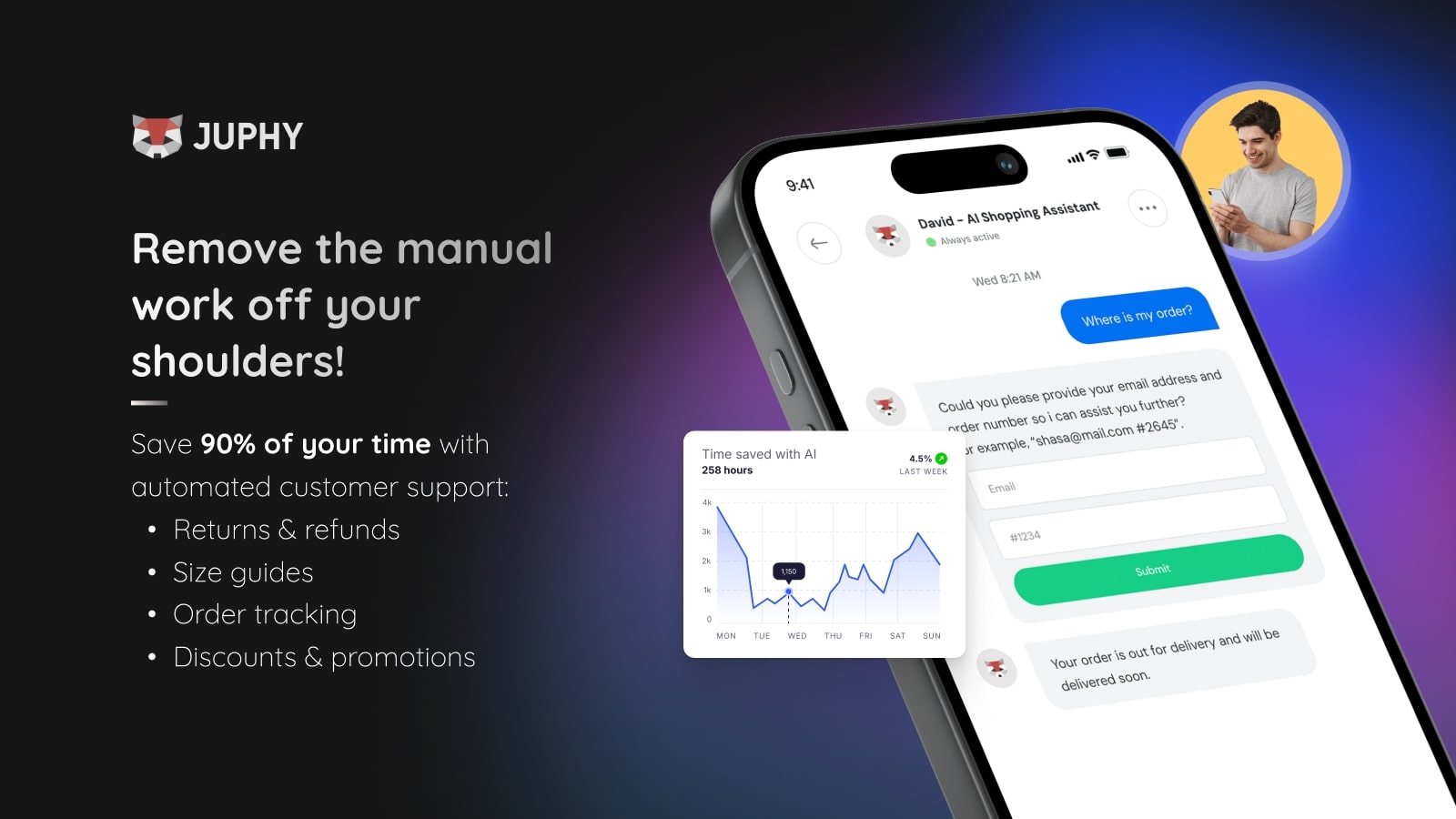How to Write a Return Policy for Your Shopify Store
Inci Vardar
Returns and refunds are factors that drive trust in an e-commerce brand. In fact, knowing that you offer a seamless return procedure encourages shoppers to buy from you repeatedly.
But there’s a catch. Without an effective method of handling returns, you’ll spend more money and time dealing with return requests. This makes writing one for your Shopify store a must-do. And, it’s not just any return policy, but a customer-friendly one.
If you’re having trouble drafting a return policy that works for both you and your customers, stick around. With this post, you’ll learn how to write a customer-friendly Shopify refund policy and communicate it with your customers effectively.

Understanding the Importance of a Return Policy
Having and communicating a refund policy for your Shopify store helps build customer trust and reduce customer disputes. But how?
Building Trust with Customers
Firstly, a refund policy signals that you’re confident about the quality of your products and thus are willing to offer a money-back guarantee. That confidence attracts customers and encourages them to buy.
Furthermore, it reduces the perceived risk of not being satisfied with their purchase, A refund policy creates a safety net for customers, assuring them that they can return the purchased product if it doesn’t meet their expectations.
A customer-friendly refund policy also shows your commitment to customer satisfaction. People will love and trust your brand knowing you care about how their products meet their needs.
Reducing Customer Disputes
A comprehensive refund policy helps reduce customer disputes because it clearly states the terms and conditions for smooth returns and refunds. The likelihood of misunderstanding the process is reduced because customers know what to expect.
Communicating your refund policy in your Shopify store also standardizes the process. So everyone that visits your store sees the terms and conditions and understands how it’s done. Then no one can say you treated them unfairly for any reason, especially when you have an efficient method of handling the returns.
Key Elements of an Effective Return Policy
Having customers return what they purchased from you seems bad for business. This might make you nonchalant about creating a refund policy. But now you know that it’ll help you build customer trust, which is a precedent for customer loyalty and retention.
Now, if you’re ready to write your own Shopify refund policy, let’s discuss the key elements of an effective return policy.
Eligibility for Returns
Your refund policy must clearly outline the type of products that can be returned as well as any exceptions to the rule.
This is important to reduce return request volumes since customers are pre-informed of the eligibility requirement for returns. It also reduces miscommunications.
Return Time Frame
The return time frame establishes the time limits for returns. For example, your refund policy can state that items can only be returned within 30 days post-purchase.
In an effective return policy, the time frame is clearly stated so that customers don’t delay for so long. Then if they return later than the stipulated period, it’ll be a fault of their own and might incur extra charges.
Condition of Returned Items
Customers should know the condition of items that they can return. For example, the refund policy may state that the item should remain in the original packaging or should have the label tag on still.
Specifying the conditions of the returned items further contributes to ensuring clarity and fairness to anyone purchasing from you. Plus it takes a lot of work out of your hands because you won’t have to send emails back and forth explaining why you can’t accept a return.
Return Process
Finally, an effective refund policy provides a step-by-step return process to reduce confusion and improve customer experience.
The return process tells customers what to do in plain and clear language. It also communicates the expectations from the return. For example, it tells customers whether they get a full refund, store credit, exchange, or other result.
Refund, Exchange, and Store Credit Policies
Moving on, let’s talk about what happens when customers return a product. What are the refund options available? What if they want an exchange? How do you handle products that were returned for being damaged?
Refund Options
You can have different refund options for your customers, depending on which is better for your business. If you offer a full refund, customers receive the full money to their original payment method. But keep in mind that full refunds can be abused. In fact, return fraud cost U.S. retailers over $100 billion in 2023.
Instead of a full refund, you can give customers store credit worth the amount of the returned product. So customers can use it to purchase other items from your Shopify store to keep the money in your business.
Exchange Policies
An exchange policy states the rules presiding exchanges for purchased items. Suppose someone buys a dress from you and discovers it’s a size smaller. Rather than a refund, you can offer an exchange with the same dress in a suitable size.
Handling Damaged or Defective Items
You need an efficient process for handling damaged or defective items. Customers must provide pictures of the item as proof of damage to facilitate the return process. This must be stated in the return policy for damaged/defective items.
Along with the return process, the return policy should contain the refund option for these items. Offering full refund off the bat may hurt your business because it’ll signal that your brand doesn’t care to make ‘amends.’ So offer to replace the item first, or give store credit. A full refund should be the last option.
Shipping and Handling for Returns
Now let’s talk about who handles the shipping costs for returns.
Return Shipping Costs
The return shipping cost is an integral part of your return policy because customers need to know who covers the cost. You can determine this based on the reason for the return.
For example, your policy may state that customers will be responsible for return shipping costs if the return is due to a change of mind or wrong size selection. Then if it’s a case of damaged/defective items, the company can handle it.
However you decide to handle the shipping, you must state the conditions on your return policy.
International Returns
A good practice for international returns is to write the policy by country. This is because Customs rules and charges differ per country. Then shipping times may vary as well.
Additionally, there are some items that the shipping cost might be more expensive than the cost of the item itself. The return policy must outline rules for such items, especially if it’s a result of a mistake on your end.
For example, if a customer orders a tripod that costs $10 and you send the wrong one. But you discover that the international shipping fee is equivalent to the cost of the item, you can just leave the item for the customer and send the right one.
Communicating Your Return Policy
Up next, you need to learn how to communicate your return policy effectively.
Where to Display Your Return Policy
You must prominently display your return policy to enhance transparency and customer trust. You can have a dedicated page for returns and include a link in your website footer like Natori in the image below.
Your product pages are also ideal for displaying your return policy.
You can also outline your return policy on the checkout page.
Finally, your FAQs page should have your return policy or link to the returns page.
You may also include a link to the returns page in order confirmation emails.
Simplifying the Language
Use clear and straightforward language in your return policy. No need for fluff or technical jargon. Keep it as concise as possible. When you explain how to do the return, use bullet points to make it easy to follow through.
Use headings and emphasize important details, like the return time frame or exceptions to return rules. Overall, use a friendly tone to convey the returns information.
Best 2 Examples from Shopify Stores
Now, let’s see two great return policy examples of Shopify stores to learn from:
1. Greats
Greats is a sneakers e-commerce store with a dedicated returns page that’s accessible from the footer of the website.
They emphasize important details like the condition of the returned item, making it difficult for customers to miss. Then they divide each policy into different segments to reduce confusion.
The returns page also explains the return process step-by-step for easy assimilation. There are also featured questions with collapsible answers to keep the page neat. If customers need more information, the contact information is clearly stated on the page.
2. Adored Vintage
Adored Vintage is another brand with a dedicated return page that we love. It’s comprehensive and segments different aspects of the return policy with headings.
From the footer, you get to a page that summarizes the refund process in steps. The page highlights the return process in bullet points to make it easy for customers to understand the content quickly.
Those looking for a comprehensive copy of the refund policy are directed to another page, which dissects each part of the return policy for easy understanding.
How Juphy Enhances Your Return Policy Process
Now that you have an effective return policy, make the process even more frictionless with ‘Built for Shopify’ badged Juphy AI. See how Juphy helps below:
Providing Real-Time Support

Use Juphy’s AI Agent to offer real-time support for return inquiries, ensuring customers receive quick and accurate information. This reduces wait time and improves customer experience. Plus Juphy is available 24/7. So, whenever the inquiry comes, you’ll be ready with an answer thanks to Juphy.
Personalized Return Assistance

With Juphy AI, provide personalized assistance to guide customers through the return process, reducing errors and enhancing satisfaction. This enhances the overall customer experience, making returns faster, smoother, and more efficient.
Conclusion
One way to encourage people to buy from you is by providing a return policy. It eases the anxiety that comes with potential dissatisfaction with a purchase. Assuring customers that they can return the product if they change their minds encourages them to buy from you.
When you use Juphy AI Agent to streamline the process, you give your customers the ultimate satisfaction because Juphy efficiently guides them through the process and provides real-time support 24/7. Ready to create an efficient return policy process? Give Juphy a chance now. Grab the free trial before it expires.
Key Takeaways
- All effective return policies contain four essential elements; the eligibility for returns, return time frame, condition of returned items, and return process.
- If an item is returned for arriving damaged/defective, your return process should request photographic proof of damage. As a resolve, offer replacements first to correct whatever impression the incident might have left.
- An effective return policy should clearly state the party that’ll cover the return shipping fee. If it’s international returns, it’s good practice to make a separate section for it as customs regulations and fees may apply.
- Use clear, straightforward language for your return policy. Explain the process in bullet points, and use headings to differentiate parts of the policy to eliminate confusion. Then display the policy prominently on the footer of your website, in product pages, check out pages, and include them in order confirmation emails.
- Beat your competition by enhancing your return page with Juphy AI Agent. It provides real-time support and personalized return assistance to enhance the return process, ensure customer satisfaction, and improve customer experience.

